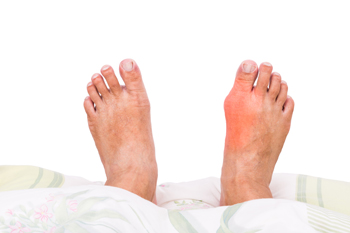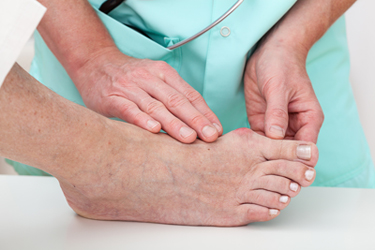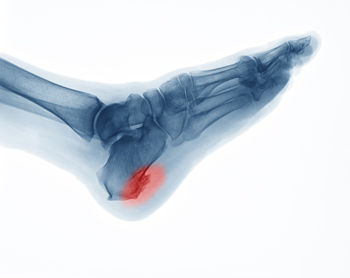Items filtered by date: July 2020
Arthritis and Gout
 Excess uric acid in the bloodstream may cause crystals to form in the joints of the big toe. This can lead to a condition that is known as gout, which can cause severe pain and discomfort. Gout is considered to be a form of arthritis, and gout attacks have the ability to start and stop suddenly. The affected toe may become inflamed and swollen, and can cause difficulty in walking. There are specific foods that can cause the uric acid levels in your bloodstream to become elevated. These can include shellfish, red meat, and drinks that are made with a large amount of sugar. Research has indicated it is beneficial to implement healthy lifestyle habits into your daily routine, as this may help to prevent gout attacks from occurring. Drinking plenty of fresh water daily, eating fruits and vegetables, and performing gentle stretches may help to ease gout pain. If you are afflicted with gout, it is suggested that you speak to a podiatrist, who can determine the correct course of treatment for you as soon as possible.
Excess uric acid in the bloodstream may cause crystals to form in the joints of the big toe. This can lead to a condition that is known as gout, which can cause severe pain and discomfort. Gout is considered to be a form of arthritis, and gout attacks have the ability to start and stop suddenly. The affected toe may become inflamed and swollen, and can cause difficulty in walking. There are specific foods that can cause the uric acid levels in your bloodstream to become elevated. These can include shellfish, red meat, and drinks that are made with a large amount of sugar. Research has indicated it is beneficial to implement healthy lifestyle habits into your daily routine, as this may help to prevent gout attacks from occurring. Drinking plenty of fresh water daily, eating fruits and vegetables, and performing gentle stretches may help to ease gout pain. If you are afflicted with gout, it is suggested that you speak to a podiatrist, who can determine the correct course of treatment for you as soon as possible.
Gout is a painful condition that can be treated. If you are seeking treatment, contact Dr. Kendall Blackwell from InStride Wilson Podiatry Associates. Our doctor will treat your foot and ankle needs.
What Is Gout?
Gout is a form of arthritis that is characterized by sudden, severe attacks of pain, redness, and tenderness in the joints. The condition usually affects the joint at the base of the big toe. A gout attack can occur at any random time, such as the middle of the night while you are asleep.
Symptoms
- Intense Joint Pain - Usually around the large joint of your big toe, and it most severe within the first four to twelve hours
- Lingering Discomfort - Joint discomfort may last from a few days to a few weeks
- Inflammation and Redness -Affected joints may become swollen, tender, warm and red
- Limited Range of Motion - May experience a decrease in joint mobility
Risk Factors
- Genetics - If family members have gout, you’re more likely to have it
- Medications - Diuretic medications can raise uric acid levels
- Gender/Age - Gout is more common in men until the age of 60. It is believed that estrogen protects women until that point
- Diet - Eating red meat and shellfish increases your risk
- Alcohol - Having more than two alcoholic drinks per day increases your risk
- Obesity - Obese people are at a higher risk for gout
Prior to visiting your podiatrist to receive treatment for gout, there are a few things you should do beforehand. If you have gout you should write down your symptoms--including when they started and how often you experience them, important medical information you may have, and any questions you may have. Writing down these three things will help your podiatrist in assessing your specific situation so that he or she may provide the best route of treatment for you.
If you have any questions, please feel free to contact our office located in Wilson, NC . We offer the newest diagnostic and treatment technologies for all your foot care needs.
How Obesity Can Hurt Your Feet
 Obesity can cause a variety of health problems throughout the entire body. One often overlooked area that is affected by obesity are the feet. Studies have found that general foot pain and plantar heel pain are strongly associated with an increase in body mass index. That is, the higher your weight, the more likely you are to develop pain in your feet. Furthermore, obese individuals are more likely to have flat feet, which can result in strained muscles and ligaments that bring about foot pain. Obese individuals are also at greater risk of developing poor circulation to the feet, peripheral artery disease, and peripheral neuropathy, all of which lead to decreased foot function. A podiatrist can help address concerns regarding your foot health, and provide advice regarding what you can do to improve it.
Obesity can cause a variety of health problems throughout the entire body. One often overlooked area that is affected by obesity are the feet. Studies have found that general foot pain and plantar heel pain are strongly associated with an increase in body mass index. That is, the higher your weight, the more likely you are to develop pain in your feet. Furthermore, obese individuals are more likely to have flat feet, which can result in strained muscles and ligaments that bring about foot pain. Obese individuals are also at greater risk of developing poor circulation to the feet, peripheral artery disease, and peripheral neuropathy, all of which lead to decreased foot function. A podiatrist can help address concerns regarding your foot health, and provide advice regarding what you can do to improve it.
Obesity has become very problematic at this point in time and can have extremely negative effects on the feet. If you’re an obese individual and are concerned about your feet, contact Dr. Kendall Blackwell from InStride Wilson Podiatry Associates. Our doctor can provide the care you need to keep you pain-free and on your feet.
Obesity and Your Feet
Since your feet are what support your entire weight when standing, any additional weight can result in pain and swelling. Being overweight is one of the main contributors to foot complications.
Problems & Complications
Extra Weight – Even putting on just a few extra pounds could create serious complications for your feet. As your weight increases, your balance and body will shift, creating new stresses on your feet. This uneven weight distribution can cause pain, even while doing the simplest tasks, such as walking.
Diabetes – People who are overweight are at serious risk of developing type-2 diabetes, which has a drastic impact on the health of your feet. As you get older, your diabetes might worsen, which could lead to loss of feeling in your feet, sores, and bruises. You could also become more prone to various infections.
Plantar fasciitis – Pressure and stress that is placed on muscles, joints, and tendons can trigger plantar fasciitis, which is an inflammation of tissue that forms along the bottom of the foot.
If you have any questions please feel free to contact our office located in Wilson, NC . We offer the newest diagnostic and treatment technologies for all your foot and ankle needs.
What is a Bunion?
 The medical term for a bunion is referred to as hallux valgus. It appears as a bony protrusion that forms on the side of the big toe and may cause wearing shoes to be uncomfortable. The big toe can become misaligned, and may affect the remaining toes. Some of the symptoms that are associated with this condition can include pain, inflammation, and the toe may appear red. If a bunion is left untreated, arthritis may develop, which can cause deeper joint pain. Genetic factors may play a significant role in developing a bunion, in addition to wearing shoes that do not have ample room for the toes to move freely in. If you notice a bump extending from your toe, it is suggested that you consult with a podiatrist who can properly diagnose and treat bunions.
The medical term for a bunion is referred to as hallux valgus. It appears as a bony protrusion that forms on the side of the big toe and may cause wearing shoes to be uncomfortable. The big toe can become misaligned, and may affect the remaining toes. Some of the symptoms that are associated with this condition can include pain, inflammation, and the toe may appear red. If a bunion is left untreated, arthritis may develop, which can cause deeper joint pain. Genetic factors may play a significant role in developing a bunion, in addition to wearing shoes that do not have ample room for the toes to move freely in. If you notice a bump extending from your toe, it is suggested that you consult with a podiatrist who can properly diagnose and treat bunions.
If you are suffering from bunion pain, contact Dr. Kendall Blackwell of InStride Wilson Podiatry Associates. Our doctor can provide the care you need to keep you pain-free and on your feet.
What Is a Bunion?
Bunions are painful bony bumps that usually develop on the inside of the foot at the joint of the big toe. As the deformity increases over time, it may become painful to walk and wear shoes. Women are more likely to exacerbate existing bunions since they often wear tight, narrow shoes that shift their toes together. Bunion pain can be relieved by wearing wider shoes with enough room for the toes.
Causes
- Genetics – some people inherit feet that are more prone to bunion development
- Inflammatory Conditions - rheumatoid arthritis and polio may cause bunion development
Symptoms
- Redness and inflammation
- Pain and tenderness
- Callus or corns on the bump
- Restricted motion in the big toe
In order to diagnose your bunion, your podiatrist may ask about your medical history, symptoms, and general health. Your doctor might also order an x-ray to take a closer look at your feet. Nonsurgical treatment options include orthotics, padding, icing, changes in footwear, and medication. If nonsurgical treatments don’t alleviate your bunion pain, surgery may be necessary.
If you have any questions, please feel free to contact our office located in Wilson, NC . We offer the newest diagnostic and treatment technologies for all your foot care needs.
My Teenager and Sever’s Disease
 The age group of people who are typically affected by Sever’s disease is between ten and fourteen. It impacts the growth plate in the heel and can cause severe pain and discomfort. It can happen as a result of participating in running and jumping activities, which can exert excess pressure on the heel. It is beneficial to perform stretches that can loosen the Achilles tendon which is connected to the heel. Additionally, many patients wear specific types of footwear that can help in the healing process. If you notice your child is limping or complaining of heel pain, it is strongly suggested that you schedule an appointment with a podiatrist who can diagnose and treat Sever’s disease.
The age group of people who are typically affected by Sever’s disease is between ten and fourteen. It impacts the growth plate in the heel and can cause severe pain and discomfort. It can happen as a result of participating in running and jumping activities, which can exert excess pressure on the heel. It is beneficial to perform stretches that can loosen the Achilles tendon which is connected to the heel. Additionally, many patients wear specific types of footwear that can help in the healing process. If you notice your child is limping or complaining of heel pain, it is strongly suggested that you schedule an appointment with a podiatrist who can diagnose and treat Sever’s disease.
Sever's disease often occurs in children and teens. If your child is experiencing foot or ankle pain, see Dr. Kendall Blackwell from InStride Wilson Podiatry Associates. Our doctor can treat your child’s foot and ankle needs.
Sever’s Disease
Sever’s disease is also known as calcaneal apophysitis, which is a medical condition that causes heel pain I none or both feet. The disease is known to affect children between the ages of 8 and 14.
Sever’s disease occurs when part of the child’s heel known as the growth plate (calcaneal epiphysis) is attached to the Achilles tendon. This area can suffer injury when the muscles and tendons of the growing foot do not keep pace with bone growth. Therefore, the constant pain which one experiences at the back of the heel will make the child unable to put any weight on the heel. The child is then forced to walk on their toes.
Symptoms
Acute pain – Pain associated with Sever’s disease is usually felt in the heel when the child engages in physical activity such as walking, jumping and or running.
Highly active – Children who are very active are among the most susceptible in experiencing Sever’s disease, because of the stress and tension placed on their feet.
If you have any questions, please feel free to contact our office located in Wilson, NC . We offer the newest diagnostic and treatment technologies for all your foot and ankle injuries.

